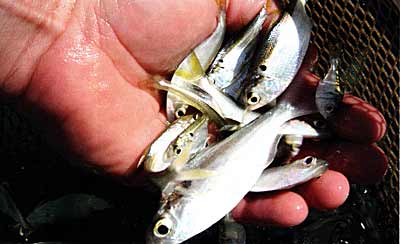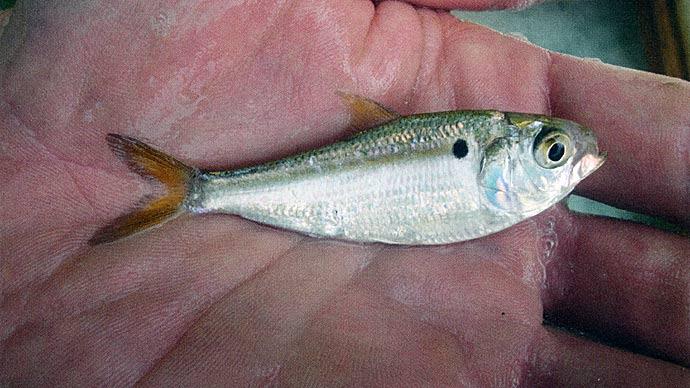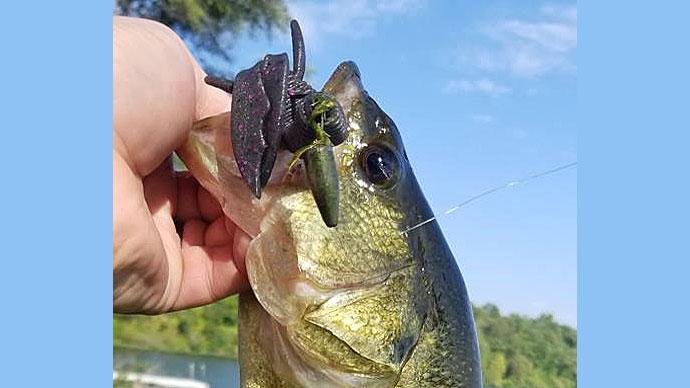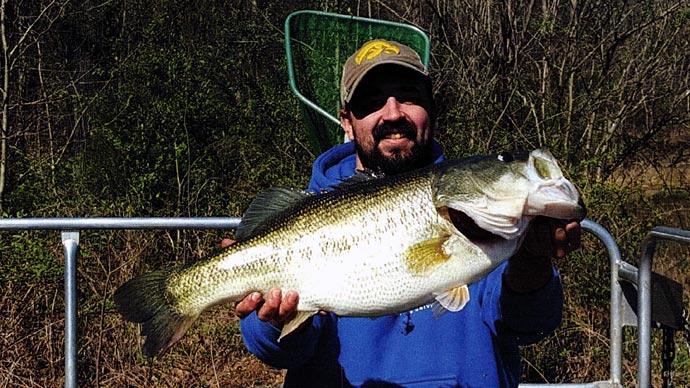
Recently, on my regular Wednesday night live broadcast on the Pond Boss Facebook page, someone asked a question about stocking gizzard shad. Someone else made a comment about threadfin shad and the conversation went off on a couple of tangents. There were proponents and opponents.
Reflecting on that exchange, it registered that it's time to revisit this topic. In my travels and conversations, I'm mostly convinced that people don't truly recognize the drastic differences between these fish.
They look quite similar. They have that silvery-color, sleek, narrow look. They both have a thread at the end of their dorsal fins. They both have black dots, right behind their heads, toward the top. Think herring.
Though they look similar, they are as different as cats and dogs. In our ponds, they serve similar purposes with totally different outcomes because of their lifestyles.
Threadfin shad live maybe two years, tops are three, if all conditions are perfect. There's so much against threadfin shad survival that the only way they can make it where conditions are survivable is to reproduce often, and in big numbers, and hope the water doesn't get too cold. Threadfins seldom grow much larger than 7-inches, and only a rare few actually grow so large. The majority of threadfins are consumed way before that. They have a terminal mouth, meaning at the end of their face, with a slightly elongated lower jaw, so their mouth is slightly turned upward. They don't have an air bladder, so they have to continually swim, or they'll just sink. The position of their mouths and the fact they have to swim all the time pushes them into open water. They filter the majority of their food from the water column in the form of plankton. In pond management, their primary role is to provide food for intermediate-sized predator fish, especially Largemouth bass. In bigger reservoirs, stripers and white bass are dependent on great hatches of threadfins. In our bass lakes, threadfins play a role of filling a niche, the open water, while providing an extra food source for young, fast-growing bass.
As they spawn just before daylight, they stick their eggs on grassy substrates in long runs along the shoreline. Shortly after sunup, they're gone. They live mostly in the upper reaches of our ponds because that's where their food tends to be densest. Eggs per female can range from 2,000 up to 20,000+. They start spawning when temperatures reach the upper 60s.
Threadfins have golden-colored tails. Gizzards have silver tails. See the differences?
Threadfins run in big schools of like-sized fish, so the age classes tend to run together. There are several other things interesting about shad. They have a black dot behind their gill plate, toward the top of the fish. Biologists believe that dot is there to trick predators. Predators go for the eyes and if a shad has something that looks like an eye, maybe it can escape. Scientists believe they travel in schools because they move in unison and a big predator fish senses the school as one big fish and may not be as likely to investigate. Once a predator comes close enough to a school, it will burst into the mass, flushing it, sending shad scattering everywhere. That movement causes confusion to the predator and many shad survive as the predator can't figure out which fish to chase—unless there are a bunch of predators chasing them. A few are eaten and the school reconvenes some distance away.
Baby threadfins mature at 90-120 days after hatching in spring. Those babies are having babies by summer, adding to the food chain for young of the year predators, if they dare venture into open water.
Key statement here—in the areas of the world where threadfins can live, great bass lakes, with big numbers of trophy-sized bass, have threadfins shad.
Those gizzard shad, though, have totally different behavior. Well, maybe not at first. Gizzard shad spawn in warmer waters than threadfins. A momma gizzard lays all her eggs at once. Depending on her age, she can lay way north of a quarter-million eggs. Do the math on that for a ten-acre lake. Baby gizzard shad hatch and head for open water for safety and to glean food from the water column. Their growth rates are much faster than threadfins, so it doesn't take long for them to catch up. It's not unusual to catch a gizzard shad hanging out with threadfins of similar size. You can tell the difference in a couple of ways. Gizzard shad have a nose, meaning their mouth sits beneath their face. Remember that. Fish with mouths under their faces are bottom feeders. Gizzard shad fins are silver, threadfin shad fins are more of a golden color, including their tails.
As the gizzard shad grows rapidly toward adulthood, its feeding habits change and the fish move from open water to the littoral zone, where it begins rooting around on the lake or pond bottom. I'll always remember arguing with Harrell Arms, many years ago, before I had any gray in my hair, before I knew much about shad. He argued that gizzard shad were bottom feeders. I disputed. Until I started dissecting the slimy, oily creatures that can grow way beyond the mouth size of most mortal Largemouth bass, I didn't truly understand just how profoundly bottom-feeder they are. They are bottom feeders, with long guts full of black gunk filtered from our pond bottoms in shallow water. Shallow water is gizzard shad heaven.
I'll always remember a fishing trip to Canada, about fifteen years ago. It was a thrill to be invited to tag along with friends and chase some smallmouth bass and walleye. We we got to the airport in International Falls, Minnesota, getting ready for the ride across the border to catch a float plane. As I stood on the tarmac waiting for a ride, a van pulled up, and I saw a guy in the van waving at me to "come here." I walked to the van, and recognized the guy waving as Johnny Morris, owner of BassPro Shops. He had several people in his entourage including Bill Dance, Charlie Campbell, and several others. I stepped to the van, looked in and Johnny said, "Pond Boss, why do they call a gizzard shad a gizzard shad?" His enthusiastic voice was contagious. I was immediately hit with a sense of horror. Before I could think about messing up in front of those guys, I said, "It's because they have a gizzard." I was settling a fun little argument without participating in it. You can't imagine the sigh of relief felt through my body.
Those gizzards have sand and rocks to grind food sucked up by those vacuum-cleaner mouths. Gizzard shad make a living off detritus, worms, bacteria, periphyton, and whatever else looms on a lake bottom. They grow really fast, so be smart if you want to use them as forage fish in your lake or pond.
I've found them in excess of two-pounds each, in schools so dense they inhibit reproduction of themselves, and other species as well. When their density reaches a certain point, they give off a pheromone dense enough to arrest reproduction.
If you plan to use them in your bass fishery, my general rule of thumb is to make sure you have at least 25% of your biomass of bass 18-inches or longer. You need plenty of big bass to eat and control gizzard shad.
One other interesting point about shad. Both species are pretty sensitive to environmental change. They need plenty of oxygen and fairly healthy water. When water quality starts to deteriorate, these two species are amongst the first to die. While threadfin shad die at 42-degrees F., gizzards can withstand cold water, under the ice. But when their density is too dense and competition for food causes them to decline, they will die from stress in cold temperatures. I think that's nature's way to thin the herd and make room for next year's babies.
If you plan to stock threadfin shad, they seem to thrive best in ponds larger than three acres. Stock adults in the spring, if you can get them. Some hatcheries don't have availability until summer, when babies grow large enough to handle. They are delicate. It doesn't take many to establish a population, unless you are putting them in a clear water lake, with over-crowded bass. Make sure your water is fertile and you have grass for them to spawn. Gizzard shad are best stocked in late winter, as spring is about to spring. Stock adults. It doesn't take many to establish, especially if egg-laden.
There's the skinny on shad. Choose well, and confidently, when you want to use them to enhance your fishing lakes and ponds.
Reprinted with permission from Pond Boss Magazine



